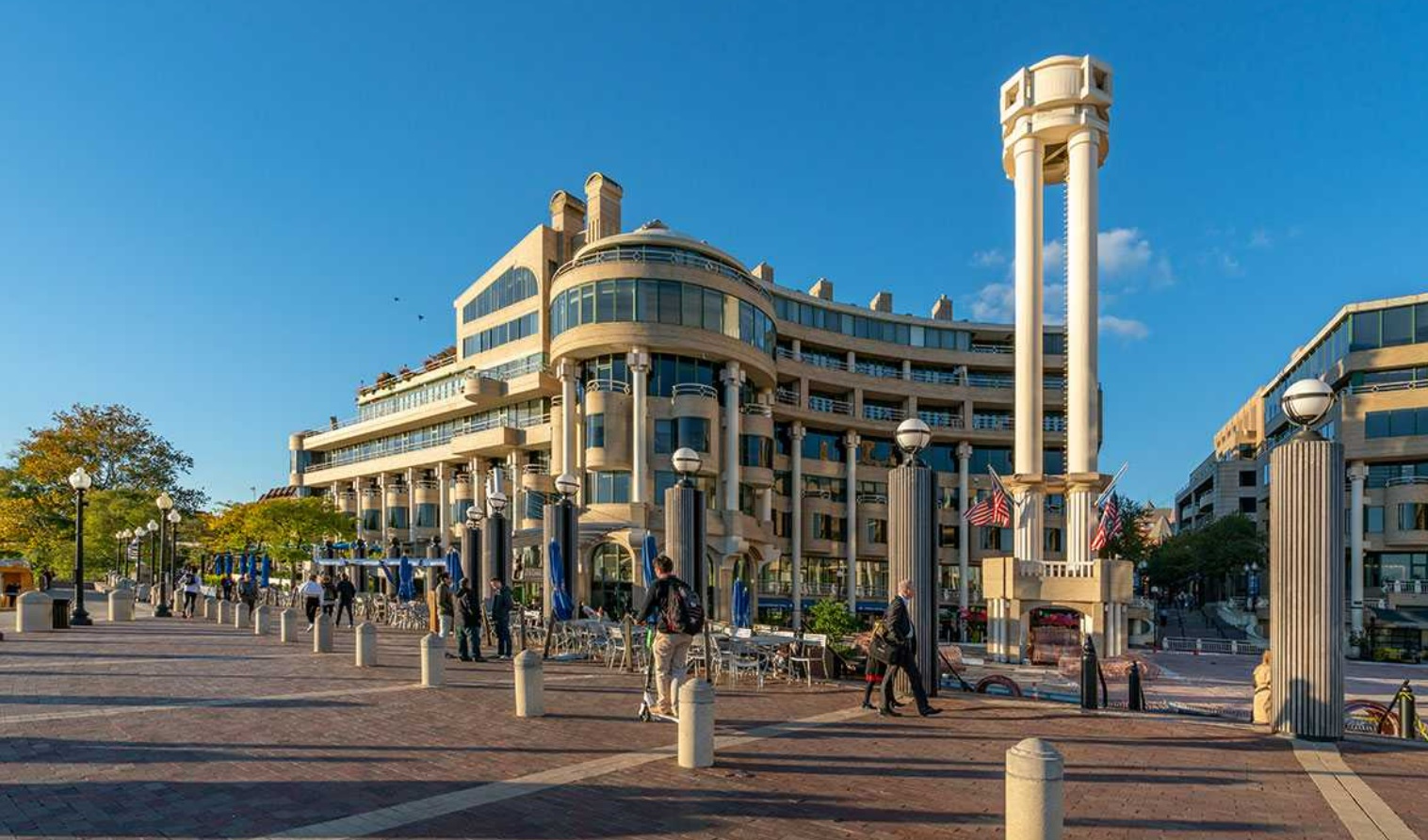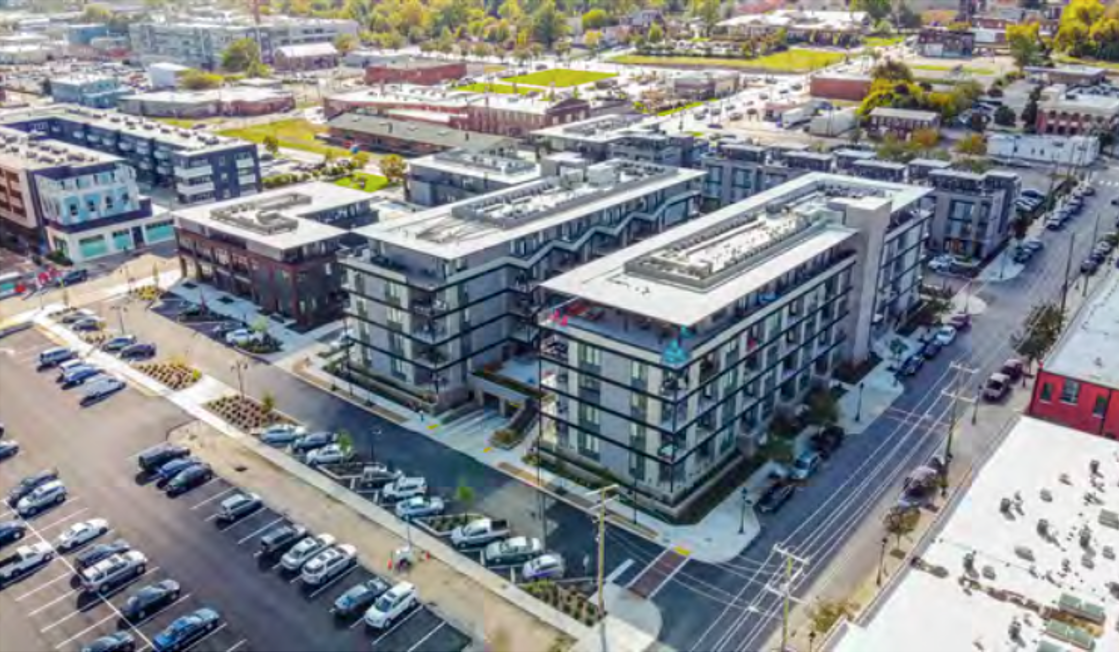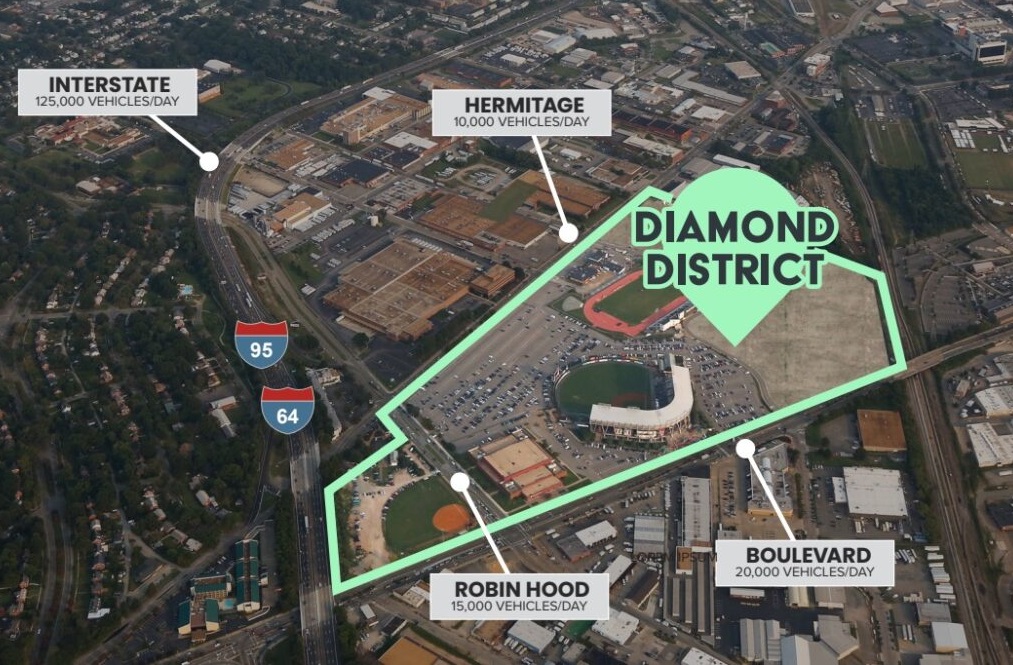
Republic Properties Corp. developed the mixed-use Washington Harbour in D.C. (Images courtesy of Republic Properties)
A local development firm that in recent years has amassed a sizable real estate portfolio in the vicinity of The Diamond is teaming up with a Washington, D.C. peer in a bid for Richmond’s Diamond District redevelopment project.
Thalhimer Realty Partners is one of the primary players behind RVA Diamond Partners, a previously unknown development team that’s one of six still in contention for the 67-acre mixed-use development that’s to include a new baseball stadium to replace The Diamond.
The lead developer on the team is Republic Properties Corp., a D.C.-based firm whose mixed-use developments there include Washington Harbour on the Georgetown waterfront, Georgetown Park, Market Square and The Portals.
Republic’s work also includes Millbrae Station, a 17-acre transit-oriented development near San Francisco International Airport. The firm also was recently selected to develop Gateway Station, a transit-oriented mixed-use development in North Carolina next to Truist Field stadium, home of the minor-league Charlotte Knights ballclub.

Republic Properties was recently selected to develop Gateway Station, a transit-oriented mixed-use development next to Truist Field stadium in Charlotte, North Carolina.
Also heading up the team is Loop Capital, a Chicago-based investment bank that’s involved in the redevelopment of the Oakland Coliseum site in California and new terminals at LaGuardia Airport and JFK Airport in New York.
DLR Group and JMI Sports are the team’s stadium designer and development consultant, respectively. DLR’s minor-league baseball credits include Fluor Field stadium in Greenville, South Carolina, while JMI worked on Chase Center in San Francisco and Petco Park, home to Major League Baseball’s San Diego Padres.
The team’s lead architect is New York-based Skidmore, Owings & Merrill. Other design firms on the team include Nelson Byrd Woltz, a landscape architecture firm out of Charlottesville; placemaking firm Groundswell Design Group, out of Philadelphia; Richmond-area firms Poole & Poole Architecture, KEI Architects and 510 Architects; and Hickok Cole, which has an office in Richmond.
The team’s hotel developer is Maryland-based Capstone Development. Its residential developers are Philadelphia-based Pennrose, Maryland-based NixDev and Richmond-based Southside Community Development & Housing Corp. Contractors on the team include Breeden Construction, Emerge Construction Group, M Companies, Prestige Construction and Whiting-Turner, all locally based.
Rounding out the group is Richmond-based J&G Workforce Development and PR firm Capital Results; D.C.-based consulting firm Robert Bobb Group; Richmond visual artist Sir James Thornhill; and food-and-beverage consultants Shemicia Bowen, Kelli Lemon and Amy Wentz, co-founders of Richmond Black Restaurant Experience.
Republic took the lead in assembling the team, reaching out first to Thalhimer Realty Partners, whose local projects include the Regency mall redevelopment (with Rebkee Co.), Brookfield Place, Westhampton Commons and City View in Manchester.
Republic’s Jordan Kramer said TRP stood out for such projects and its history in Richmond, as well as its affiliation with commercial real estate brokerage Cushman & Wakefield | Thalhimer.
“We pursue a lot of public-private partnerships, and we’ve learned that you need to do your homework when you’re coming into another market,” Kramer said.
“We looked at a lot of local developers, and we found that TRP delivered a lot of great projects and they’re among the most successful in Richmond. They have a relationship with Cushman, which means they have incredible insights across uses.”
TRP Principal Jason Guillot said the firm’s interest in the area is reflected in the investments it has made in recent years around The Diamond and in nearby Scott’s Addition. Its holdings include the shuttered Pet Dairy property just east of The Diamond. It’s also working with Charlotte-based Crescent Communities on a 272-unit apartment building across Arthur Ashe Boulevard from The Diamond.
“It’s been part of our plan long term to expand in that direction,” Guillot said. “The 67 acres across the street dwarfs what we have, but we want to be a part of it. We’re all in on Scott’s Addition and the Diamond District.”
Guillot said the team is approaching its bid in keeping with the vision of the Richmond 300 master plan. He said their proposal would also follow the city’s recommendation of locating a new stadium along Arthur Ashe Boulevard just south of The Diamond, to allow the Richmond Flying Squirrels to continue playing ball while working to meet the goal of a new ballpark by the 2025 season.
Major League Baseball set that deadline for all pro baseball venues to meet new facility standards. The Flying Squirrels has been promised a new ballpark since the Double-A club’s arrival in 2010.
“It’s an extremely tight timeframe. What the city’s asking of these six development teams is to move heaven and earth to deliver that stadium by the time baseball season starts in 2025,” Guillot said.
“The city did a great job through Richmond 300 articulating the vision. We feel like our plan honors that,” he said. “What we’ve done is put pen to paper and made it pencil out, so we actually have a sustainable business model to make this project work for decades.”
Part of that plan includes a tax increment financing district, or TIF, that Guillot said would be restricted to the 67 acres that make up the project area. TIF districts are an option that local governments can use to help pay for a project using tax revenues generated over time.
“The city has asked that the financial proposals include no out-of-pocket dollars from the city’s general fund. This is exactly what we’ve proposed,” Guillot said. “Funds created through the TIF would be used to first and foremost pay down the cost to construct the stadium and associated infrastructure.”
Kramer said they’re also pledging to forego any operating profits from the new stadium.
“That’s how we feel we’re going to put skin in the game,” Kramer said. “We really want to see it built. We understand the value it creates for the rest of the project.”
Overseeing the financial part of the team’s proposal is Rufus Williams, a managing director at Loop Capital in its LoopWealth division. Williams said Loop Capital is the largest black-owned investment banking firm in the country, with over $4 trillion in debt and equity work completed since inception 24 years ago.
More than half of the team’s members are minority- or woman-owned businesses, the group said. Minority business involvement was encouraged in the city’s solicitation for the project.
Williams said he also has a personal connection to the project as a fraternity brother of Arthur Ashe, the late tennis great and namesake of Arthur Ashe Boulevard and the Arthur Ashe Jr. Athletic Center that’s part of the project site.
“As we start to look at things that reflect around that, it means a lot to us in that process, and personally as well,” Williams said.
Noting Loop’s work on the Oakland Coliseum site, Williams added, “That’s where the Oakland A’s play. We’re also looking to build a football stadium there and trying to bring an NFL franchise back to that city, so a lot of what we’re doing is tied directly into this kind of project that we’re talking about here in Richmond.”
Mike Hopkins, whose Emerge Construction firm’s credits include Richmond’s Black History Museum and the second phase of The Cooperage, where the company is based, said the team’s proposal would include job training aimed at extending the project’s impact across all of Richmond.
“We understand how to make this a benefit more than just for Scott’s Addition or this side of the river,” Hopkins said. “We have a major job training initiative that we’re going to bring people from the Southside in on, and we brought in Southside Community Development.
“Most of the time in Richmond, the Northside and Southside don’t work together. Part of this team’s strategy was to make sure that people from the Southside felt inclusive.”
Guillot added that the initiative would include a workforce development center that would be located in Southside.
“Whatever happens with the 67 acres, it’s going to be transformative on Arthur Ashe Boulevard and Scott’s Addition, but we thought it was really important to be inclusive for the Southside of Richmond and make sure that the people who live and work there get something out of the equation, too.”
In addition to a 10,000-capacity stadium to replace the 37-year-old Diamond, which has been deemed unfeasible for renovation, the Diamond District project calls for a mix of development including office, mixed-income residential, retail and a hotel, as well as upgrades to infrastructure such as water, sewer and roads.
Guillot said they view the project as an opportunity not only for a new stadium and housing, but also to recruit new businesses to Richmond. He said the team’s proposal would include nearly 1 million square feet of office space.
“We think this is an awesome recruiting ground for the city to bring new jobs and companies to Richmond,” Guillot said, noting Cushman & Wakefield | Thalhimer’s involvement in site search and selection when Costar Group expanded to Richmond.
“We’ll be marketing the office space, and we believe we have the best platform on a global basis to recruit new companies to Richmond,” Guillot said. “It’s not just about the baseball stadium and places for people to live; it’s about new jobs to the city.”

Thalhimer Realty Partners’ developments include City View Lofts and The Overlook at City View in Manchester.
Kramer said TRP’s holdings around the Diamond District could present opportunities to build off the development. Guillot agreed.
“If you’re one parcel on the block, you have little effect on the change in the neighborhood. If you own two, three or four, all of a sudden you can upgrade the profile of a neighborhood and have a larger positive effect on the community around you. We’ve been trying to do that in incremental steps,” Guillot said. “The fact that we have a critical mass of land around the project, we think, will be helpful.”
An evaluation panel is now reviewing additional information that was requested from the six development teams. The deadline for that info was Monday.
The panel is aiming to narrow the field down by the week of May 9 to a shortlist of finalists, who would be invited to submit proposals by June 6. City officials would then negotiate with one or more finalists and make a final selection by the end of June.

The 60-plus acres of the Diamond District are bordered by Arthur Ashe Boulevard, Hermitage Road, the interstate and the railroad tracks. (BizSense file)
The other five teams that remain in contention are:
Diamond District Gateway Partners, consisting of local real estate investment firm Capital Square, D.C.-based developers Dantes Partners and Hoffman & Associates, Maryland-based real estate firm The Velocity Cos., architecture firms Baskervill and Pendulum, engineering firms VHB and Froehling & Robertson, and general contractors Clancy & Theys and Barton Malow.
MAG Partners, a New York City-based developer working with Seattle-based developer MacFarlane Partners, D.C.-based developer Jair Lynch Real Estate Partners, real estate investment firm MSquared, architecture firms AtelierTek and Woods Bagot, engineering firms Kimley-Horn and Thornton Tomasetti, sports venue developer CAA Icon, and placemaking and workforce firm C Space.
Richmond Community Development Partners, consisting of Houston-based Machete Group, developers JMA Ventures and Sterling Project Development, construction firm Gilbane, hotel management and advisory firm Retro Hospitality, architecture firm Hanbury, engineering firm VHB and planning nonprofit Storefront for Community Design.
Vision300 Partners LLC, including developers Freehold Communities, Greenstone Properties, KDC and Spy Rock Real Estate Group; local building firm Hourigan; housing nonprofit Better Housing Coalition, construction firm Canterbury Enterprises, Shamin Hotels, YMCA of Greater Richmond, Brookfield Asset Management, and Richmond-based Sports United Ltd.
Weller Development Co. and LMXD, consisting of Weller, a Baltimore-based developer, and LMXD, affiliated with New York-based L+M Development Partners.

Republic Properties Corp. developed the mixed-use Washington Harbour in D.C. (Images courtesy of Republic Properties)
A local development firm that in recent years has amassed a sizable real estate portfolio in the vicinity of The Diamond is teaming up with a Washington, D.C. peer in a bid for Richmond’s Diamond District redevelopment project.
Thalhimer Realty Partners is one of the primary players behind RVA Diamond Partners, a previously unknown development team that’s one of six still in contention for the 67-acre mixed-use development that’s to include a new baseball stadium to replace The Diamond.
The lead developer on the team is Republic Properties Corp., a D.C.-based firm whose mixed-use developments there include Washington Harbour on the Georgetown waterfront, Georgetown Park, Market Square and The Portals.
Republic’s work also includes Millbrae Station, a 17-acre transit-oriented development near San Francisco International Airport. The firm also was recently selected to develop Gateway Station, a transit-oriented mixed-use development in North Carolina next to Truist Field stadium, home of the minor-league Charlotte Knights ballclub.

Republic Properties was recently selected to develop Gateway Station, a transit-oriented mixed-use development next to Truist Field stadium in Charlotte, North Carolina.
Also heading up the team is Loop Capital, a Chicago-based investment bank that’s involved in the redevelopment of the Oakland Coliseum site in California and new terminals at LaGuardia Airport and JFK Airport in New York.
DLR Group and JMI Sports are the team’s stadium designer and development consultant, respectively. DLR’s minor-league baseball credits include Fluor Field stadium in Greenville, South Carolina, while JMI worked on Chase Center in San Francisco and Petco Park, home to Major League Baseball’s San Diego Padres.
The team’s lead architect is New York-based Skidmore, Owings & Merrill. Other design firms on the team include Nelson Byrd Woltz, a landscape architecture firm out of Charlottesville; placemaking firm Groundswell Design Group, out of Philadelphia; Richmond-area firms Poole & Poole Architecture, KEI Architects and 510 Architects; and Hickok Cole, which has an office in Richmond.
The team’s hotel developer is Maryland-based Capstone Development. Its residential developers are Philadelphia-based Pennrose, Maryland-based NixDev and Richmond-based Southside Community Development & Housing Corp. Contractors on the team include Breeden Construction, Emerge Construction Group, M Companies, Prestige Construction and Whiting-Turner, all locally based.
Rounding out the group is Richmond-based J&G Workforce Development and PR firm Capital Results; D.C.-based consulting firm Robert Bobb Group; Richmond visual artist Sir James Thornhill; and food-and-beverage consultants Shemicia Bowen, Kelli Lemon and Amy Wentz, co-founders of Richmond Black Restaurant Experience.
Republic took the lead in assembling the team, reaching out first to Thalhimer Realty Partners, whose local projects include the Regency mall redevelopment (with Rebkee Co.), Brookfield Place, Westhampton Commons and City View in Manchester.
Republic’s Jordan Kramer said TRP stood out for such projects and its history in Richmond, as well as its affiliation with commercial real estate brokerage Cushman & Wakefield | Thalhimer.
“We pursue a lot of public-private partnerships, and we’ve learned that you need to do your homework when you’re coming into another market,” Kramer said.
“We looked at a lot of local developers, and we found that TRP delivered a lot of great projects and they’re among the most successful in Richmond. They have a relationship with Cushman, which means they have incredible insights across uses.”
TRP Principal Jason Guillot said the firm’s interest in the area is reflected in the investments it has made in recent years around The Diamond and in nearby Scott’s Addition. Its holdings include the shuttered Pet Dairy property just east of The Diamond. It’s also working with Charlotte-based Crescent Communities on a 272-unit apartment building across Arthur Ashe Boulevard from The Diamond.
“It’s been part of our plan long term to expand in that direction,” Guillot said. “The 67 acres across the street dwarfs what we have, but we want to be a part of it. We’re all in on Scott’s Addition and the Diamond District.”
Guillot said the team is approaching its bid in keeping with the vision of the Richmond 300 master plan. He said their proposal would also follow the city’s recommendation of locating a new stadium along Arthur Ashe Boulevard just south of The Diamond, to allow the Richmond Flying Squirrels to continue playing ball while working to meet the goal of a new ballpark by the 2025 season.
Major League Baseball set that deadline for all pro baseball venues to meet new facility standards. The Flying Squirrels has been promised a new ballpark since the Double-A club’s arrival in 2010.
“It’s an extremely tight timeframe. What the city’s asking of these six development teams is to move heaven and earth to deliver that stadium by the time baseball season starts in 2025,” Guillot said.
“The city did a great job through Richmond 300 articulating the vision. We feel like our plan honors that,” he said. “What we’ve done is put pen to paper and made it pencil out, so we actually have a sustainable business model to make this project work for decades.”
Part of that plan includes a tax increment financing district, or TIF, that Guillot said would be restricted to the 67 acres that make up the project area. TIF districts are an option that local governments can use to help pay for a project using tax revenues generated over time.
“The city has asked that the financial proposals include no out-of-pocket dollars from the city’s general fund. This is exactly what we’ve proposed,” Guillot said. “Funds created through the TIF would be used to first and foremost pay down the cost to construct the stadium and associated infrastructure.”
Kramer said they’re also pledging to forego any operating profits from the new stadium.
“That’s how we feel we’re going to put skin in the game,” Kramer said. “We really want to see it built. We understand the value it creates for the rest of the project.”
Overseeing the financial part of the team’s proposal is Rufus Williams, a managing director at Loop Capital in its LoopWealth division. Williams said Loop Capital is the largest black-owned investment banking firm in the country, with over $4 trillion in debt and equity work completed since inception 24 years ago.
More than half of the team’s members are minority- or woman-owned businesses, the group said. Minority business involvement was encouraged in the city’s solicitation for the project.
Williams said he also has a personal connection to the project as a fraternity brother of Arthur Ashe, the late tennis great and namesake of Arthur Ashe Boulevard and the Arthur Ashe Jr. Athletic Center that’s part of the project site.
“As we start to look at things that reflect around that, it means a lot to us in that process, and personally as well,” Williams said.
Noting Loop’s work on the Oakland Coliseum site, Williams added, “That’s where the Oakland A’s play. We’re also looking to build a football stadium there and trying to bring an NFL franchise back to that city, so a lot of what we’re doing is tied directly into this kind of project that we’re talking about here in Richmond.”
Mike Hopkins, whose Emerge Construction firm’s credits include Richmond’s Black History Museum and the second phase of The Cooperage, where the company is based, said the team’s proposal would include job training aimed at extending the project’s impact across all of Richmond.
“We understand how to make this a benefit more than just for Scott’s Addition or this side of the river,” Hopkins said. “We have a major job training initiative that we’re going to bring people from the Southside in on, and we brought in Southside Community Development.
“Most of the time in Richmond, the Northside and Southside don’t work together. Part of this team’s strategy was to make sure that people from the Southside felt inclusive.”
Guillot added that the initiative would include a workforce development center that would be located in Southside.
“Whatever happens with the 67 acres, it’s going to be transformative on Arthur Ashe Boulevard and Scott’s Addition, but we thought it was really important to be inclusive for the Southside of Richmond and make sure that the people who live and work there get something out of the equation, too.”
In addition to a 10,000-capacity stadium to replace the 37-year-old Diamond, which has been deemed unfeasible for renovation, the Diamond District project calls for a mix of development including office, mixed-income residential, retail and a hotel, as well as upgrades to infrastructure such as water, sewer and roads.
Guillot said they view the project as an opportunity not only for a new stadium and housing, but also to recruit new businesses to Richmond. He said the team’s proposal would include nearly 1 million square feet of office space.
“We think this is an awesome recruiting ground for the city to bring new jobs and companies to Richmond,” Guillot said, noting Cushman & Wakefield | Thalhimer’s involvement in site search and selection when Costar Group expanded to Richmond.
“We’ll be marketing the office space, and we believe we have the best platform on a global basis to recruit new companies to Richmond,” Guillot said. “It’s not just about the baseball stadium and places for people to live; it’s about new jobs to the city.”

Thalhimer Realty Partners’ developments include City View Lofts and The Overlook at City View in Manchester.
Kramer said TRP’s holdings around the Diamond District could present opportunities to build off the development. Guillot agreed.
“If you’re one parcel on the block, you have little effect on the change in the neighborhood. If you own two, three or four, all of a sudden you can upgrade the profile of a neighborhood and have a larger positive effect on the community around you. We’ve been trying to do that in incremental steps,” Guillot said. “The fact that we have a critical mass of land around the project, we think, will be helpful.”
An evaluation panel is now reviewing additional information that was requested from the six development teams. The deadline for that info was Monday.
The panel is aiming to narrow the field down by the week of May 9 to a shortlist of finalists, who would be invited to submit proposals by June 6. City officials would then negotiate with one or more finalists and make a final selection by the end of June.

The 60-plus acres of the Diamond District are bordered by Arthur Ashe Boulevard, Hermitage Road, the interstate and the railroad tracks. (BizSense file)
The other five teams that remain in contention are:
Diamond District Gateway Partners, consisting of local real estate investment firm Capital Square, D.C.-based developers Dantes Partners and Hoffman & Associates, Maryland-based real estate firm The Velocity Cos., architecture firms Baskervill and Pendulum, engineering firms VHB and Froehling & Robertson, and general contractors Clancy & Theys and Barton Malow.
MAG Partners, a New York City-based developer working with Seattle-based developer MacFarlane Partners, D.C.-based developer Jair Lynch Real Estate Partners, real estate investment firm MSquared, architecture firms AtelierTek and Woods Bagot, engineering firms Kimley-Horn and Thornton Tomasetti, sports venue developer CAA Icon, and placemaking and workforce firm C Space.
Richmond Community Development Partners, consisting of Houston-based Machete Group, developers JMA Ventures and Sterling Project Development, construction firm Gilbane, hotel management and advisory firm Retro Hospitality, architecture firm Hanbury, engineering firm VHB and planning nonprofit Storefront for Community Design.
Vision300 Partners LLC, including developers Freehold Communities, Greenstone Properties, KDC and Spy Rock Real Estate Group; local building firm Hourigan; housing nonprofit Better Housing Coalition, construction firm Canterbury Enterprises, Shamin Hotels, YMCA of Greater Richmond, Brookfield Asset Management, and Richmond-based Sports United Ltd.
Weller Development Co. and LMXD, consisting of Weller, a Baltimore-based developer, and LMXD, affiliated with New York-based L+M Development Partners.




The City has some great development teams from which to choose a “winner”. I have my fingers crossed that there is at least one applicant that will not include a TIF that covers a geographic area larger than it’s own 67 acres. I’d like to see the improvements support itself without encumbering a larger swath of future tax revenue.
If this is the team responsible for that unbelievably bad design in that first image, i cant unsee that! What have you done! You should be ashamed of yourselves, you don’t advertise that! For the sake of all Architecture, design and humanity please stop! Clearly, I’ve not been to Washington Harbour and having seen that I would be physically ill if I did visit. That image alone should remove this group from contention. My day is now ruined.
I would hope you have a background in development to judge the design renderings. Speaking on topics you don’t understand make you sound pretentious.
I infact do have a background in design and development. Over 20 years. Terrible looking building.
I don’t agree with your rhetoric, but I do agree with your opinion. That rendering is an architectural hot mess.
I’ve actually seen a LOT worse…… when there is a LOT of money thrown at a project in a big city, it is pretty amazing the SCALE of something that is both really ugly and, somehow, also not very interesting — you almost what the hulking costly thing to be MORE ugly….
Not my favorite but is still a lot more interesting than a lot that is built in Richmond, now and historically. Some version of “don’t look at me, I’m modestly like was built before…” Lots of roundedness… maybe that is why Richmonders would be offended — roundedness only okay if copying neoclassical pillars, which are copies of classical pillars, perhaps?? Do Richmonders hate “organic-looking” forms? Like if someone built something that looked like a yurt or had a bunch of yurt-looking things in the facade they would demand something that looked more Georgian? They seem kinda proud of Monticello… that… Read more »
I’m glad to see that the city of Richmond and developers still working on developing RVA to be a more livable and enjoyable city. Scott’s addition always been a great part of the city but these plans will definitely elevate the appeal. Love to see it.
ALWAYS been a great part of the city???? Is the neighborhood to the North-West a great part of Henrico County?
Let’s start with Fluor Field Stadium. It opened in 2006, seats 6700 and is a baseball ONLY stadium for a high A East affiliate of the Boston Red Sox, which is why the stadium has a “Green Monster,” slightly lower than the one at Fenway Park (30 feet high vs. 37 feet high), but all of the other dimensions are the same. The stadium is along the railroad tracks which , in my opinion, was a good idea and should be replicated at The Diamond District. There appears to be apartments at the rear, which is not uncommon today with… Read more »
At least they admitted the City’s timetable is close to unreasonable especially for the stadium; that is kind of refreshing. I can’t wait to see the “rinse and repeat” spin on the TIF. Not going to have any liability to taxpayers……ha ha ha ha….not once in the history of the City have any lender or institutions not at least required the bonds have a more obligation clause. A moral clause if ignored and bonds not paid hurt your general obligation and other bonds ratings. Hence why the City took the “never gonna fail” Broad St CDA, closed the organization, and… Read more »
What he’s saying is true. No matter what you hear about the public not being liable for repaying loans, the opposite holds true. The bond holders always look to the public entity in the event of default.
This likely makes the terms cheaper for the borrower.